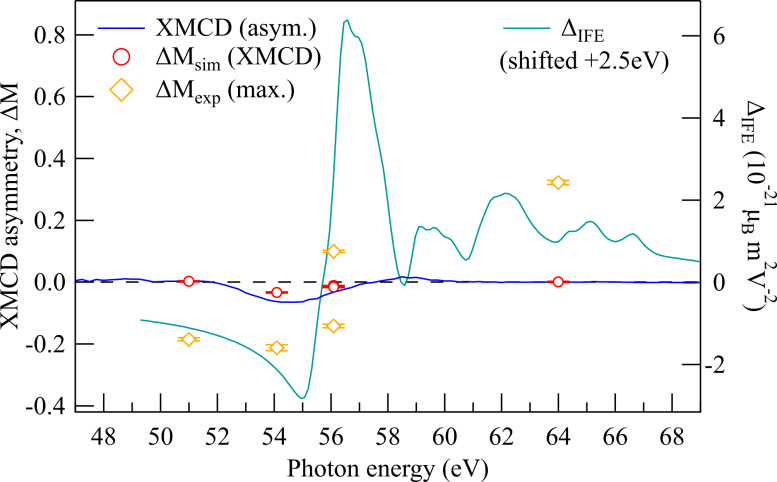博文
革命性的磁性:偏振光解锁超快数据存储和自旋电子学
 精选
精选
||
革命性的磁性:偏振光解锁超快数据存储和自旋电子学
诸平
据德国马克斯·玻恩非线性光学与短脉冲光谱学研究所{Max Born Institute for Nonlinear Optics and Short Pulse Spectroscopy (MBI) / Max-Born-Institut für Nichtlineare Optik und Kurzzeitspektroskopie, Max-Born-Straße 2A, Berlin, Germany}2024年7月7日提供的消息,革命性的磁性:偏振光解锁超快数据存储和自旋电子学(Revolutionizing Magnetism: Polarized Light Unlocks Ultrafast Data Storage and Spintronics)。相关研究结果于2024年6月14日已经在《通讯物理》(Communications Physics)杂志网站在线发表——Martin Hennecke, Clemens von Korff Schmising, Kelvin Yao, Emmanuelle Jal, Boris Vodungbo, Valentin Chardonnet, Katherine Légaré, Flavio Capotondi, Denys Naumenko, Emanuele Pedersoli, Ignacio Lopez-Quintas, Ivaylo P. Nikolov, Lorenzo Raimondi, Giovanni De Ninno, Leandro Salemi, Sergiu Ruta, Roy Chantrell, Thomas Ostler, Bastian Pfau, Dieter Engel, Peter M. Oppeneer, Stefan Eisebitt, Ilie Radu. Ultrafast opto-magnetic effects in the extreme ultraviolet spectral range. Communications Physics, 2024, 7, Article number: 191. DOI: 10.1038/s42005-024-01686-7. Published: 14 June 2024. https://www.nature.com/articles/s42005-024-01686-7
参与此项研究的除了来自马克斯·玻恩非线性光学和短期光谱学研究所的研究人员之外,还有来自法国巴黎索邦大学、法国国家科学研究院物质与辐射物理化学实验室(Sorbonne Université, CNRS, Laboratoire de Chimie Physique ‒ Matière et Rayonnement, LCPMR, Paris, France)、加拿大国家科学研究所(Institut National de la Recherche Scientifique, INRS-EMT, Varennes, QC, J3X 1P7, Canada)、意大利巴索维扎的里雅斯特电子同步加速器(FERMI, Elettra-Sincrotrone Trieste, Basovizza, Trieste, Italy)、西班牙萨拉曼卡大学(University of Salamanca, Salamanca, Spain)、 斯洛文尼亚新戈里察大学(University of Nova Gorica, Nova Gorica, Slovenia)、瑞典乌普萨拉大学(Uppsala University, P.O. Box 516, SE-751 20, Uppsala, Sweden)、英国约克大学(University of York, York, YO10 5DD, UK)、英国谢菲尔德·哈勒姆大学(Sheffield Hallam University, Howard Street, Sheffield, S1 1WB, UK)、英国赫尔大学(University of Hull, Cottingham Road, Hull, HU6 7RX, UK)、德国柏林工业大学(Technische Universität Berlin, Straße des 17. Juni 135, Berlin, Germany)以及德国谢讷费尔德的欧洲x射线自由电子激光器(European X-ray Free-Electron Laser, Holzkoppel 4, Schenefeld, Germany)的研究人员。
新研究引入了一种利用圆偏振极紫外(extreme ultraviolet简称XUV)光进行磁化的非热方法(non-thermal method),该方法通过逆法拉第效应(inverse Faraday effect)引起显著的磁化变化,有可能会改变超快数据存储和自旋电子学(spintronics)。
强烈的激光脉冲可以用来在极短的时间尺度上操纵甚至切换材料的磁化方向。通常,这种效应是热诱导的,因为吸收的激光能量非常迅速地加热材料,导致磁序的超快扰动。
来自马克斯·玻恩研究所(Max Born Institute简称MBI)的科学家们与一个国际研究团队合作,现在已经证明了一种有效的非热方法来产生大的磁化变化。通过将铁磁铁钆(Fe-Gd)合金暴露在极紫外(XUV)辐射的圆极化脉冲中,它们可以显示出特别强的磁响应,这取决于入射的XUV光爆发的旋向性(左旋圆极化或右旋圆极化)。
潜在的机制是基于逆法拉第效应,它不依赖于光的吸收,而是在其极化和这种材料中的磁矩之间提供有效的相互作用。
用偏振光控制磁性(Controlling Magnetism With Polarized Light)
当一个强烈的激光脉冲击中磁化介质时,其对磁化强度的影响通常可以归因于当它被吸收时引入材料的能量。从微观上看,这与电子的光激发相对应,电子迅速进入非平衡状态,并开始与彼此和其他准粒子散射,改变电子自旋和轨道矩,从而改变远程磁化。
尽管这种机制产生了各种迷人的现象,包括超快退磁(ultrafast demagnetization)和激光诱导磁化开关(laser-induced magnetization switching),但它们是以材料的大量热负荷为代价的,限制了在需要快速重复率的地方的技术适用性,例如,未来数据存储技术中的读/写操作。
逆法拉第效应和光磁现象(The Inverse Faraday Effect and Opto-Magnetic Phenomena)
由MBI的科学家领导的一个国际研究小组现在已经研究了一种完全不同的、通过光操纵磁性的非热途径。他们的方法是基于一种光磁现象(opto-magnetic phenomenon),这种现象不依赖于光的吸收引起的电子加热,而是依赖于光的极化和电子自旋之间的直接、相干的相互作用。
潜在的机制是逆法拉第效应(inverse Faraday effect简称IFE),它导致在被圆极化辐射光激发的介质中产生磁矩,磁化方向取决于圆极化的左旋性或右旋性,即其螺旋性(helicity)。然而,由于大多数铁磁和反铁磁材料的金属和高吸收特性通常会抑制上述非热效应,因此必须开发一种特殊技术来产生相当大的光磁响应。
利用自由电子激光FERMI产生的极紫外(XUV)辐射的圆偏振飞秒脉冲,科学家们可以证明在金属铁磁铁钆(FeGd)合金中产生特别强的IFE诱导磁化。这是可能的,因为XUV辐射的高光子能量,允许紧密结合的核能级电子的共振激发,由于它们的固有性质(特别是强自旋-轨道耦合),有利于产生大的光磁效应。
用XUV演示大的磁化变化(Demonstrating Large Magnetization Changes Using XUV)
通过这种方法,科学家们可以证明,对于Fe M3,2核级共振周围不同的XUV光子能量,通过圆极化XUV脉冲的相反螺旋性诱导的超快退磁之间的差异来测量,IFE诱导的磁化强度可以达到FeGd合金基态磁化强度的20%~30%(图1)。
在从头算理论(ab initio theory)和自旋动力学模拟(spin dynamics simulations)的支持下,也可以证明观察到的效应与预期的IFE响应一致(图2),并且不能用纯粹的热螺旋相关机制来解释,例如已经建立的x射线磁圆二色性(x-ray magnetic circular dichroism简称XMCD)。
这些发现为在超快时间尺度上非热产生大磁化提供了一种有效的方法,有望在超快磁学、自旋电子学、相干磁化控制和非线性x射线物质相互作用科学等领域发挥重要作用。
本研究得到了德国联邦教育和研究部{ Federal Ministry of Education and Research (BMBF) through project 05K16BCA (Femto-THz-X)}、欧洲研究委员会{ European Research Council through project TERAMAG (Grant No. 681917)}、德国研究基金会{ German Research Foundation (DFG) for funding through CRC/TRR 227 projects A02 and MF (project ID 328545488)}、ARCHER英国国家超级计算服务(ARCHER UK National Supercomputing Service via the project e733)、EPSRC TERASWITCH项目{ EPSRC TERASWITCH project (project ID EP/T027916/1)}、瑞典研究理事会{ Swedish Research Council (VR)}、K.和A.瓦伦堡基金会{ K. and A. Wallenberg Foundation (Grants No. 2022.0079 and 2023.0336)}、欧盟地平线2020研究与创新计划{European Union’s Horizon 2020 Research and Innovation Programme under FET-OPEN Grant Agreement No. 863155 (s-Nebula)} 以及瑞典国家计算基础设施{Swedish National Infrastructure for Computing (SNIC), funded by VR through grant No. 2018-05973}的资助或者支持。
上述介绍,仅供参考。欲了解更多信息,敬请注意浏览原文或者相关报道。
Coherent light-matter interactions mediated by opto-magnetic phenomena like the inverse Faraday effect (IFE) are expected to provide a non-thermal pathway for ultrafast manipulation of magnetism on timescales as short as the excitation pulse itself. As the IFE scales with the spin-orbit coupling strength of the involved electronic states, photo-exciting the strongly spin-orbit coupled core-level electrons in magnetic materials appears as an appealing method to transiently generate large opto-magnetic moments. Here, we investigate this scenario in a ferrimagnetic GdFeCo alloy by using intense and circularly polarized pulses of extreme ultraviolet radiation. Our results reveal ultrafast and strong helicity-dependent magnetic effects which are in line with the characteristic fingerprints of an IFE, corroborated by ab initio opto-magnetic IFE theory and atomistic spin dynamics simulations.
https://blog.sciencenet.cn/blog-212210-1441716.html
上一篇:科学家开发出使建筑物冬暖夏凉的被动机制
下一篇:科学家发现新酶,为绿色癌症治疗铺平道路


